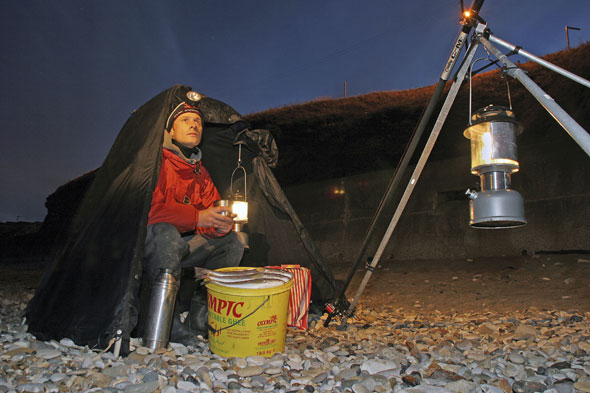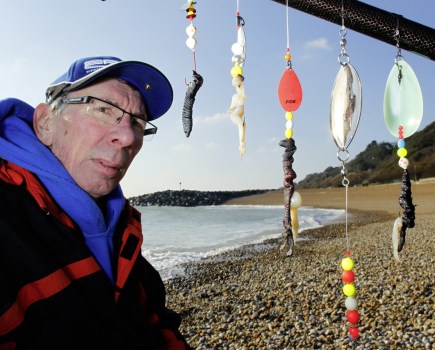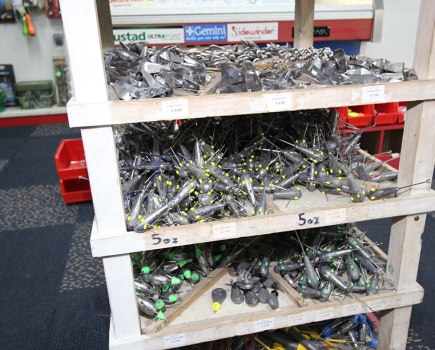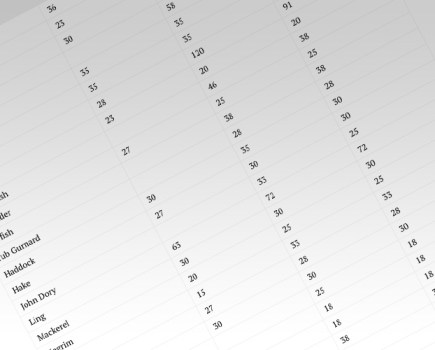As daylight fades fish move close to the shore to feed, knowing they can hide in the shadows from marauding predators. Fishing under the cover of darkness an angler can boost his chances of having a great night out…simply because the fish are in casting range
NIGHTFALL BRINGS ITS problems. The black blanket that creeps over a desolate or remote beach can be eerie and at times you can feel isolated while the beach itself can be a dangerous place to the unwary.
Anglers tend to band together and the most productive night venues are fairly crowded, especially at weekends so if you are nervous of the night there are plenty of places you can fish in company and this includes well-lit promenades and piers.
But if you are fearless then the night offers a multitude of fishing opportunities to get your hook bait close to the bigger fish, although fishing with a pal is generally considered more safe and sensible especially if you are adventurous and fish the more remote and dangerous marks.
Angling after dark has its hot periods and on most venues the best times to fish are between 8pm and 3am with high water before midnight.
For a few early-rising species like soles, bass and rays the hours before dawn can be deadly, but in general two hours either side of midnight is the time to expect cod, whiting, pouting, dogfish, bass, conger eels and many others.
A few species do not generally feed in the dark and they include wrasse, plaice, mullet and mackerel, although there are exceptions.
Calm, clear nights are generally more productive than when the sea is rough and coloured because the fish often feed much closer to shore in daylight in such conditions.
In calm, gin-clear water fish are more active in darkness, while a full moon can be a deterrent to fish coming inshore on some shallow venues.
There are few hard and fast night fishing rules, although clearly tide times are often a crucial factor and these vary between venues.
Best nights to fish are early winter when it is cold and frosty and the beach crunches underfoot. Invariably whiting are climbing the rod tip and the key species, like cod, are on the cards.
PICK THE RIGHT SPOT
THE first job when picking a fishing mark is to check it out in daylight. Visit during low tide to determine the layout of the sea bed.
This way you can avoid snags, check out casting distances to prominent features like rocks, sandbars and gullies or the beach lip and, most importantly, check access and safety of the mark.
Turning up on a strange venue in darkness is fraught with dangers, especially on long low water venues, rock marks and cliffs. Make sure you are aware of your exit and that the place you are going to fish isn’t threatened by things like rogue waves and swell.
Most night anglers prefer to fish venues with a short distance between high and low water tidemarks. This allows you to set up a base and do away with the need to continually move with the tide.
Where you actually set up base camp can greatly affect your fishing so pick your spot with care. Take into account the tidal direction and strength. Remember the flood and ebb will run in opposite directions, so stay down tide of groynes where your tackle may get swept into if you are uptide.
Your base camp needs to be back from the high tide mark. Check out the beach ridges or the position of the flotsam on the last tideline and take into account the tides and weather. Neap tides drop back while springs push up the beach, while a building wind may push the sea in further at high tide.
Base camp should be centred around a shelter or even a basic umbrella. It keeps gear and bait dry, is somewhere to retreat to and it becomes the centre of your angling world.
Position your camp just back from the beach ridge allowing room for your rods to sit on a rod-rest to the front or side. Add a fuel lantern and you have an oasis of comfort that can make even the coldest dampest nights enjoyable to fish.
Most beach anglers rely on a headlamp while moving about outside the base camp area, while an increasing number use electric base lamps as well. Dual halogen, LED headlamps offer a light spread and a beam combined with the latest lightweight Nicad batteries.
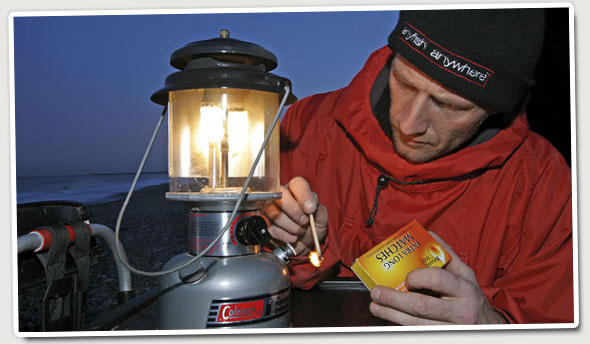
GET THE LAYOUT RIGHT
A COMPACT and well-organised base from which to fish, especially on the beach, prevents gear being lost and allows vital tackle to be placed near at hand when required.
Take special care with bait, which is susceptible to the weather; rain and a chilling wind will kill worms. Your bait also needs to be organised away from clumsy feet. Don’t lay your complete supply out to face the elements, just unwrap what is required for a few casts.
Similarly having spare terminal rigs at hand is essential. They can be pre-baited to save fishing time between casts, known as double-patting, and should be positioned safely out of the way. Most of the rod-rests have rig bars and rig clips and these are ideal for this.
Spare reels are essential in case of an overrun, tangle or line loss due to snags. Nothing is worse than having to untangle or reload a reel on the beach; fishing time lost always coincides with the time the fish start biting.
If you use a fuel-powered lantern then it will benefit from being raised off the ground. If you are not superstitious an unturned bucket does the job, but an adjustable light pole is better because the higher you place the lamp the bigger its pool of light.
To the back of the shelter goes spare clothing where it will remain dry, along with food and drinks that should always be close to hand.
There are lots of small items you can easily lose in the dark. Essential items like bait cotton always go walk about, so it is a good idea to have a spare supply. Keeping it in a tube helps and soon you will be able to buy a bright day-glo orange bait cotton container, which shouldn’t get lost.
Similarly knife, scissors, baiting needles and line clippers are easy to bury in the beach. An empty ice cream container makes a handy ready-to-use bits bin.
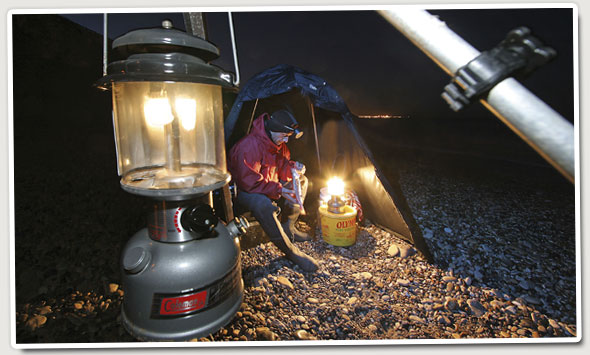
Making yourself comfortable on the beach at night is the first step towards a successful fishing session
HOW TO SOLVE ALL THOSE ANNOYING NIGHT-FISHING PROBLEMS
● Petrol lamps burst into flames or won’t light: This problem can be solved completely by burning a dangerous, smelly fuel lantern in the bin and getting one that works.
Alternatively buy an electric headlamp and or base light. Modern LEDs have increased the light output and drastically lowered the drain on batteries and this kind of lighting is now the most economic and least messy.
Best of the fuel lanterns are the oldstyle paraffin fuelled brass Tilley lamp. Coleman petrol lamps are popular but they need maintaining, especially once they are a couple of years old.
● Can’t cast in the dark: Lots of novice anglers find it difficult to cast during darkness because they cannot tell when their lead weight has hit the sea. The answer is to switch to a fixedspool reel, which doesn’t overrun.
Another alternative is to load your multiplier reel with less line and tighten up the magnetic/brake spool control.
Remember the fish are feeding closer to the shore so you do not have to hit the horizon anyway.
Practise and start with a well-lit venue before fishing in total darkness.
● Can’t spot bites: A Starlite whipped on the rod tip with bait elastic is ideal for bite spotting. Alternatively paint your rod tip white; Tippex typewriter correction fluid is ideal or wrap a tapered strip of reflective tape around the tip. Problem solved.
Beware of placing your rod tip too high because continually looking up will give you a stiff neck. Place the tip at eye level where it is more comfortable to see. A double rod-rest with a spare rod also helps spot variations in tip movement and is handy tip when it’s windy.
● I get cold and fall asleep: Preparation is the key to lasting the all night course and a good sleep the night before helps. Beer, beach fires and sleep will leave you cold and miserable at dawn.
Wear lots of thin layers of clothing, plus waterproof salopettes and jacket, to keep warm and don’t forget a hat. Food and hot drinks are essential for long sessions. A spare jumper or fleece to wear at dawn, when it is coldest, is a good idea.
● Can’t put up a brolly or shelter on the prom: For umbrellas the solution is one of the freshwater brolly attachments, like Octoplus, which fits a Breakaway seat backrest.
You can try strapping the brolly to your box with a luggage strap and pile stones on the edge. For shelters you can use beach stones or water in a couple of buckets or plastic bags, but remember to dispose of them properly when you leave. Cable ties, luggage straps and rope all help keep shelters stable close to fences, railings and groynes.
